In our second installment of my bespoke shoe journey with Saint Paul, Minnesota shoemaker Amara Hark Weber, we’ll talk about putting the “bespeak” into bespoke. “Bespeaking” basically means discussing the shoe that you finally end up with. You’ll be able to follow the entire process along the way. We’ll provide food for thought, and we talk about things like the last, the broguing, the leather, and all the details such as the heel pitch that goes into a custom pair of shoes.
Why Is Bespeaking A Pair of Shoes Important?
Basically, it’s the opportunity for you to dream out loud about your perfect shoe. Since you’re building a pair of shoes from the ground up, the sky’s the limit.
You can be inspired by an existing pair of shoes – a design that you want to improve. Start from scratch or combine the best of many worlds in one. Conversely, your shoemaker will help you; guide you along the way. They’ll talk about different costs of different details, where something is feasible, where they think they can do it, or if they’re uncomfortable working in that way. Basically, you’re telling the shoemaker what you would like and they reply to you with what is feasible in the real world.

Based on the conversation you’re having, they may even suggest certain features to you or if you say, “Well, I like this,” and they go they say, “Have you thought about this,” and pull something out of their drawers or show you some past work they’ve done. Because, if you’re, for example, interested in certain types of broguing, they can show you what they’ve done and that really helps you to learn something that you may not have otherwise known.
Bespeaking Your Shoes: It Pays To Do Your Research
While shoemakers will be perfectly fine with starting the bespeaking process in person, we believe the real bespeaking process starts long before the first conversation. Why? Well, think about it this way: the more research you do beforehand, the more things you can point out that you like and dislike, the easier, more fluid, and quicker the entire speaking process will be.
I found researching on Instagram was much more fruitful than going to bespoke shoemaker’s websites. By using hashtags like #BespokeShoes, #AlligatorShoes, or #FiddlebackWaist, you also find shoemakers that you don’t know about, but they are really good at tagging their stuff so you come up with lots of interesting visual material.

Be creative with your hashtags. You can search for leathers, the heel, the waist, the stitching, the brogues – whatever it is that you like. Once you find a shoemaker, you can also go to their archive and start albums with all the ideas and features that you like and dislike. To keep myself organized, I saved the pictures and created albums so I had all the things that I wanted in a shoe and that I did not want.
Of course, you’re not just limited to pictures. If you have videos or actual shoes that you want to bring in person, please do so.
Personally, I wanted a bespoke look AKA something unique that I couldn’t get from a factory shoe. For some reason, if you can’t find the things you’re searching for on Instagram, maybe a Google image search will yield the results or maybe going to eBay.

As you start out, you may not know what type of shoe you want. Is it a loafer? Is it an Oxford, a derby, or a boot? And it’s okay not to know that. But, if you do, of course, you can narrow down your research. That being said, don’t be afraid to change your mind. Maybe you want a Chelsea boot when you start out, but, then, you realize what you really need is an Oxford.
If your shoemaker is tech-savvy like Amara is, consider creating a shared folder on Dropbox or Google Drive, so you can share ideas; you can have a repository. Because, sometimes, the best ideas don’t come to you when you’re focused in a session, but at home when you’re sitting on a toilet.
With Amara, I had her cell phone number, I knew her Instagram handle, and had her email address, so we communicated in three different ways.

As Amara noted, people use different words for the same thing and the same words for different things. I also found that showing a picture is even much easier than trying to explain it. Frankly, there are so many decisions to make and details to consider that I found it really helpful to have a space where I could put down my thoughts at different points in time.
I also shared all these notes and photos with Amara before I visited her for the first time because, that way, she could prepare for the meeting, and maybe she saw something that I really liked and she could pull it out from her archives. Also, the shoemaker gets a better understanding of how much or how little you know about the process and they can fill in the gaps.
When you meet the shoemaker in order to bespeak your shoes, I find it valuable to have time and not to feel rushed. I also know that I’m a very detail-oriented person, so I budgeted at least two hours. Of course, we also film, which takes more time, but I think it would be terrible to cut this process short. I also think it’s important that you’re comfortable and at ease.

I found Amara’s store very welcoming, I found her as a person really charming, and I think we just had a good vibe and we connected. Because of that, I felt like I could really express myself, I could ask all the questions I wanted, and share all the things that popped into my head. I think if you don’t like the shoemaker or if the vibe is off and the communication doesn’t work, I can see how the whole process is a lot more cumbersome and unpleasant. And maybe at this stage, you realize this is not the person you want to work with. And that’s okay.
Tell Your Shoemaker About Your Vision
Most shoemakers want an idea of what they want to talk about, so they don’t forget about anything.
We started first talking about lasts. Every good shoemaker I’ve ever met is proud to show you their lasts. And, typically, if you don’t see any lasts at a shoemaker, I would think twice if I would want to work with them. Why? Well, if you’re not practicing making bespoke shoes, chances are the final result is not great.
Larger bespoke operations will have entire rooms and shelves full of bespoke lasts. Amara had all of hers hanging from her shop ceiling, so it was easy to look at them and go through them. It’s good to have in mind what it is that you want.
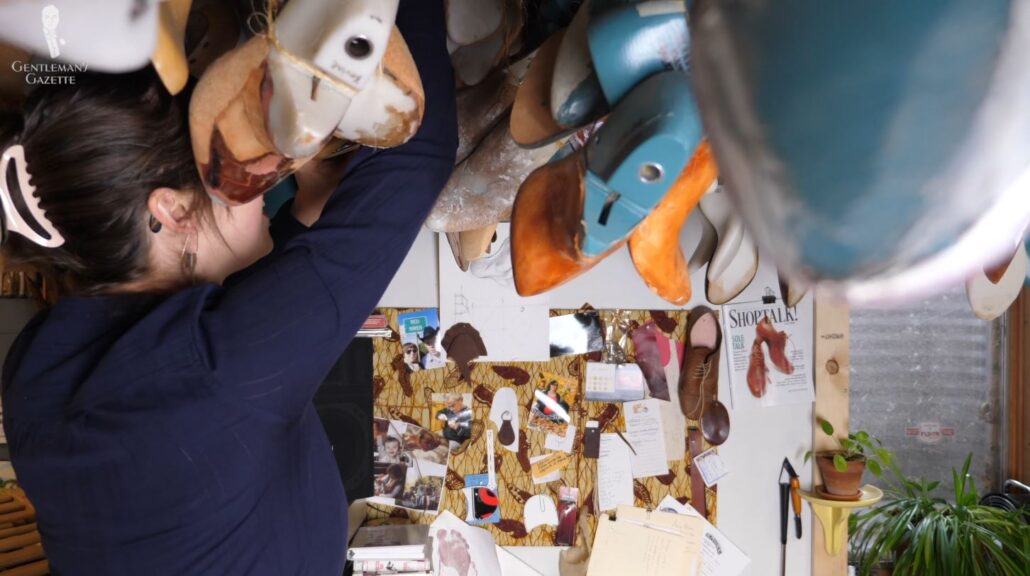
Do you want something sleek, something more Parisian, or something more in a Budapest or Hungarian style with a double sole? Do you want a more substantive shoe, do you want a boot that is really hard-wearing, or do you want something that is supremely elegant?
As you share your vision of the shoe, the shoemaker can point you in the right direction and say, “Oh, have you seen this? Do you like this? How about that?”
Of course, at this point, they’ve also investigated your feet thoroughly. So, maybe you have these big feet with a gigantic hammer toe. In that case, that super tight chisel is probably not going to be in your future.
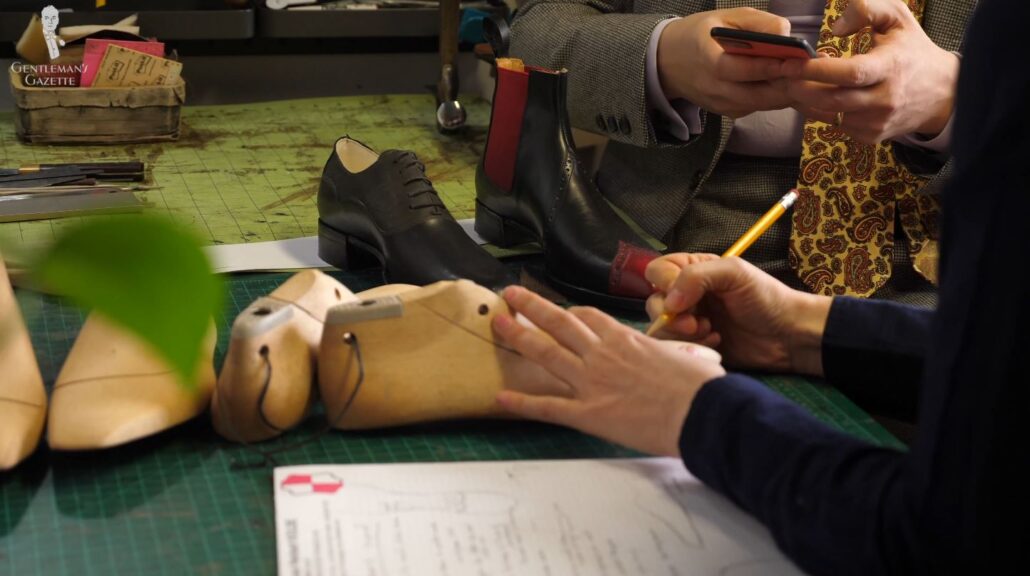
A good shoemaker will let you know about that and will say, “Well, if you want that style with your feet, be ready for some discomfort,” or “I suggest you go with this because of that.” Don’t just tell them what you want, but listen with an open mind to what they have to say.
Shoemakers like these have so much experience. They’ve done this so many times, and there’s a value in that experience. For example, Amara showed me what she called her “magic base last.” She said it fit many people and could be altered to accommodate various styles and widths. She also had that last in two different blank version sizes, so she could literally make a shoe last for any type of foot. By looking at the actual last, you will get a basic idea of the general feel and look of the final shoe.

Of course, some shoemakers don’t use base lasts, and they carve something from a solid piece of wood, but they’ll always be able to show you finished lasts.
When going for the last, consider the toe style. Is it round, almond-shaped, chiseled, or something else? Take the last in your hand, look at the left and right shoe, turn them around, look at the curves, and compare them between different lasts. See what you like and don’t like.

Once you and your shoemaker have found a last that you like, you can discuss more practical issues. For example, how much can be altered to fit me for my intended purpose, do you know if you like your shoes super tight or do you like them to be roomier, and how does it work with that last and your foot?

I found a last that was chiseled that I really liked, and Amara thought it was a good option for me because it could be rounded and widened as needed for my foot.
The Swiss design is very clean. it’s got a kind of chiseled toe, but this toe is flexible enough that allows me to either make a rounded toe … or you can make it a little bit wider… It’s just it’s a very versatile base.
Amara Hark Weber
Of course, without compromising the overall effect of the existing shoe look and base style. Always keep in mind when looking at lasts that the final shoe will look much softer and less pronounced than the last you see.
Don’t believe me? Just compare the last and the shoe that was made from it. You can also take a closer look at the shoe tree for example and the final shoe, and you’ll see they’re not quite the same.


So, if you’re in love with the exact look of a last, you have to talk to the shoemaker so they can then make a last that is more extreme, so you get that result that you’re desiring. Of course, keep in mind that a shoe is basically last plus several layers of leather. So, if you want it slimmer, the last has to be really thin. And, of course, it’s not just your upper layer of leather. There’s also lining and sometimes leather items in between. And all that builds up the look and makes it less extreme and pronounced.
After you’ve settled on a last shape and maybe even a toe shape, now, it’s time to discuss the basics of the shoe. And yes, you can change the toe shape later on if you figure that the styles you chose would actually look better with a different style, but you’ll have to start somewhere.
This conversation can get very technical, so rely on the guidance of your shoemaker to explain things to you. And if you don’t understand what they’re saying because it’s the words or maybe it just doesn’t make sense to you, just speak up.

Frankly, Amara and I discussed many details in the shoemaking process – down to the type of nails I want to use because I always thought that thinner nails looked a lot more elegant than ones with a chunky head. There are forged tacks in blue steel, brass, or stainless steel. You can have lost head nails, or sometimes shoemakers even clip off the heads so you just get a very tiny look.
Various lusters and head shapes will both have practical and aesthetic impacts on the shoe. I was interested in thin, brass nails because they typically set apart the shoe from a mass-produced one.
Listen and Let Your Shoemaker Guide You
I learned quite a bit in those conversations, so be all ears, listen to your shoemaker, and let them guide you. They know what they’re doing. Heels are another important topic in bespoke shoemaking, and they actually take quite a bit of time if you build them up by hand.
Most people might not even think about it; but it’s not just about the heel height, but also about a specific shape, how tapered it is, and how many layers of leather you want. There’s no right or wrong. It’s all about your personal preference and the comfort that you seek.

The same is true for the heel stack, which is the amount of leather layers in a heel. Some people consider more, finer layers to be more desirable because it looks different. But, it’s also more labor-intensive to make. This choice comes at an increased cost, so the shoemaker will be able to tell you how much more expensive it will be or if it’s all fine and you can choose whatever you want.
The construction of the heel itself can be different. You can dry build it or wet build it. Little touches like these of a Cuban heel and the exact angle are all details you typically will not find in a factory-made shoe, but they are the beauty of a bespoke shoe.


I talked extensively about all these little details, yet we didn’t really settle on the final shape of the heel until we discussed the cap toe or – better yet – the faux cap toe, which was pointed. Why? Well, eventually, we took that same pattern we had on the cap toe and transferred that triangular shape into the heel.
Shoe Toe Shapes and Detailing Explained
Negotiate On Your Special Requests
During the bespeaking process, you also want to mention any special requests. For example, someone may not like any metal in their shoes, so instead of a metal shank, you have to use a wooden shank; instead of metal nails, you have to use wooden pegs.
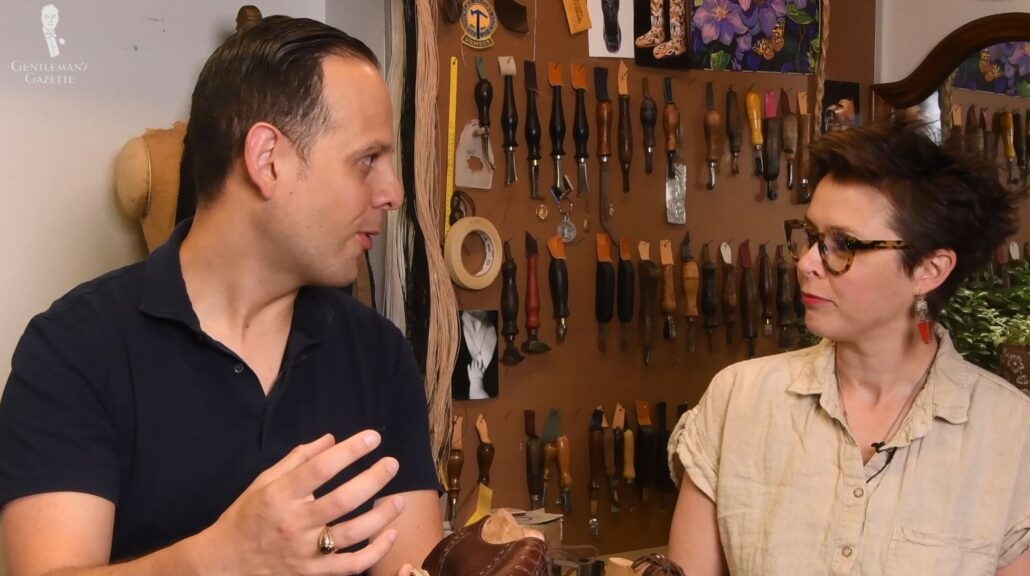
But, the question is: is the shoemaker comfortable and able to work with these different materials, or do they just rely on one thing that they know and they do really well?
Ultimately, your shoemaker may or may not be able to do it, but there’s no harm in asking. Having covered the basics, Amara and I went from heel to tip to make sure we don’t forget anything in the bespeaking process.
We talk about the heel, the sole, its thickness, the kind of leather you want, the lining, maybe the colors, maybe you want just natural non-chromed hand leather that is aniline-dyed – or whatever it is that you want for your foot, this is the time to bring it up.

In my case, I knew I didn’t want boots, but a shoe. But, we still have to discuss the lacing system or lack thereof.
It’s often said that your first pair of bespoke shoes should be a black pair of cap-toed Oxfords. We believe that it entirely depends on your preference and your needs. If you’re an investment banker and you wear black, cap-toed Oxfords, by all means, go with that. If you’re an artist and you never wear black shoes, of course, that’s a bad choice.
In my conversation with Amara, I mentioned that I have mostly Oxfords, some derbies, and some loafers. Nevertheless, I decided to go with an Oxford shoe as my first because I felt that I would get the most use out of it.

I mentioned all the curvature and details I had in mind, and Amara was able to turn around on the spot and draw it onto paper. It was really nice to see something that I had in mind come to life in their vision on paper; to the extent, that I could not have done it myself.
Always be sure to explain what you find appealing and, if you don’t have the right word, use a picture. This is where your previous research really comes in handy because, sometimes, it may be frustrating when you want to communicate something, but the shoemaker doesn’t seem to understand.
Have An Open Conversation
Most shoemakers will also have a base way to do things if it’s not specified by the customer. For example, Amara typically does a heel about one inch tall. If your shoemaker has a particular reason for doing things, they’ll typically be able to explain to you why, but it’s all based on their experience and how they’re comfortable doing things. Trying to make them do it in an entirely different way may not yield the results you’re after.
If there’s a contradiction between something that you want or something that you read and a shoemaker and their ability, just discuss it, and bring it up. For instance, on the welt, Amara typically does eight stitches per inch or two and a half centimeters. I asked if she could do 12 and she said, yes, she could.

For the sole, I knew I wanted something slimmer that was elegant and not something that was super thick with a double sole because I already own a lot of shoes. So, wearing things out was not a concern for me.
Of course, someone else may have a much smaller shoe closet and so having a bespoke shoe that doesn’t wear out quickly is their first and foremost concern. For the waist of the shoe, I showed Amara an example of a fiddleback waist, and she pulled up a shoe and said, “Hey, what do you think of this?” and I was like, “Yes, like that.”

Of course, it gave me confidence in my choice because I knew she had already done it in the past and that there was no question that she could deliver. Also, keep the overall aesthetic in mind. Amara said that the slimmer the waist, also the slimmer the heel has to be. This type of guidance can be really helpful because you may think you want all these details combined in a shoe. But, as the shoemaker envisions the shoe in their head, they can tell you this is actually at odds and, typically, it doesn’t go well together.

We also discussed toe spring because I mentioned that my shoes typically wear out first at the tip. Currently, it’s popular to put in irons at the front of the shoe with screws. But, at home, we’ve really nice parquetry floors and so, I didn’t want to damage that with metal. Therefore, we decided to go with a bit of toe spring, and skip the metal plate, so, I could wear these shoes in my own home. This is a great example of how a shoemaker’s expertise can prevent problems before they even start.

Of course, you want your shoes to be comfortable, but comfort is highly subjective. Naturally, you also want a good fit, but what feels like a good fit to you may be very different from the next customer who comes after you.
I mentioned to Amara that I had relatively flat feet, and she already had seen it herself, but she could take all my feedback into consideration and make sure that she carved the insoles accordingly. She also was able to take special care of the areas where I experienced foot pain in.

For instance, she would put additional padding on a tongue because that’s typically where you would feel a shoe. For the lining, ask your shoemaker what they typically do. Amara, for example, uses a softer lining with a stiffer upper and a stiffer lining with a softer upper.

Of course, there are also veg-tan linings and chrome tan linings, and different colors that you can choose from. When choosing a color, keep in mind that your feet sweat. When you wear light-colored socks, that dye may come up onto your socks and ruin them. That’s especially true if you have lighter-colored socks, but since we make socks ourselves at Fort Belvedere, it wasn’t a big concern for me. So, I went with a colorful lining or, at least, that was my preference.
To me, choosing bolder colors is one of the big benefits of going bespoke or having something custom-made for me. In line with that, I wanted a bespoke look, which included no center seam at the back of the heel uppers. Why? Well, most factory shoes have a seam there.
So, with a bespoke shoe, you can really go with a seamless design and look. I know most people will never notice, but I do and everyone into that stuff will do, too, for sure. This is what is known as a “true wholecut,” where you just take one piece of leather, cut it, and then pull it over the last without any seam. Amara was honest and said that she had never done something like that; that she wasn’t sure she could do it. At the same time, she was willing to give the world, which I thought was quite good.
![Seamless Shoe A pair of "true whole cut" bespoke shoes [Image Credit: The Old Reader]](https://www.gentlemansgazette.com/wp-content/uploads/2022/07/seamless-shoe-1030x579.jpg)
That being said, always pay attention to what they’re comfortable with and what they’re willing to do. There is a reason for that. For example, I showed Amara tooling on the heel that I liked. She was concerned it might only work with particular types of leather. So, instead, she suggested a unique line stitch, but I didn’t like the mock-up of it, so we just dropped it.

Know Your Options
I was also curious as to what options I had to incorporate my initials on the shoe. I mean, I had lots of practical advice to share on how the final initials would look good. Keep in mind, that I opted for a fiddleback waist, so having three initials is a lot more challenging than on a rounded waist.
What did we ultimately decide on? You have to stay tuned for the final product reveal!
Of course, you also want to talk about the material, which is typically leather. Some shoemakers will refuse to work with anything but leather because leather has a very unique ability to stretch and adapt to the shape of a last. Others may be open to work with vegan leather or fabric, and you have to talk to them about it.

Personally, I think fabric can work, especially in a spectator for example, but it won’t last as long as leather, and vegan leather is a terrible option to begin with because it simply won’t age well.
Many people will tell you that black should be the first color of your bespoke shoes, but I knew that wasn’t for me. Why? My wardrobe is varied, I have enough black shoes, and I just wanted something different. If you think about it, there’s one shade of black, but there are hundreds or thousands shades of brown. I was also floating the idea of maybe a dark navy or something in gray with Amara.

It’s great to talk to your shoemaker with the leather because they will have firsthand experience of how it handles, differences in quality, and what they like and dislike about it. For example, Amara shared with me a sample of high-quality leather from tanner in New York that is family-owned and has been doing it for 400 years.
This is a vegetable-tanned leather from a tannery in New York. They’re beautiful skins. They’re used a lot for different types of things. A lot of bookbinders use this leather, also.
Amara Hark Weber
Together, we also looked at shark skin, elephant skin, and ostrich or alligator. Why? Well, again, it’s a bespoke shoe. The sky’s the limit. Wanted to, at least, explore what’s out there. Amara thought that ostrich leather would be great for those shoes, but I felt like I didn’t want to look like a Russian pimp. So, instead, I opted for Russian reindeer.

The original Russian reindeer leather came from a ship that sank in 1786. But, it’s interesting. If you look around the internet today and see how many people claim that their leather goods are made from that leather, it almost seems like there’s an infinite amount of leather that was on that ship.
Personally, I didn’t want to bother with trying to find the original stuff and I went straight to a quality from J & FJ Baker from England that makes this leather. It comes from a tannery with lots of pedigree. It is made from very durable leather, and it has a wonderful smell that’s very smoky and very gentlemanly. And I think it comes from the use of birch oil.
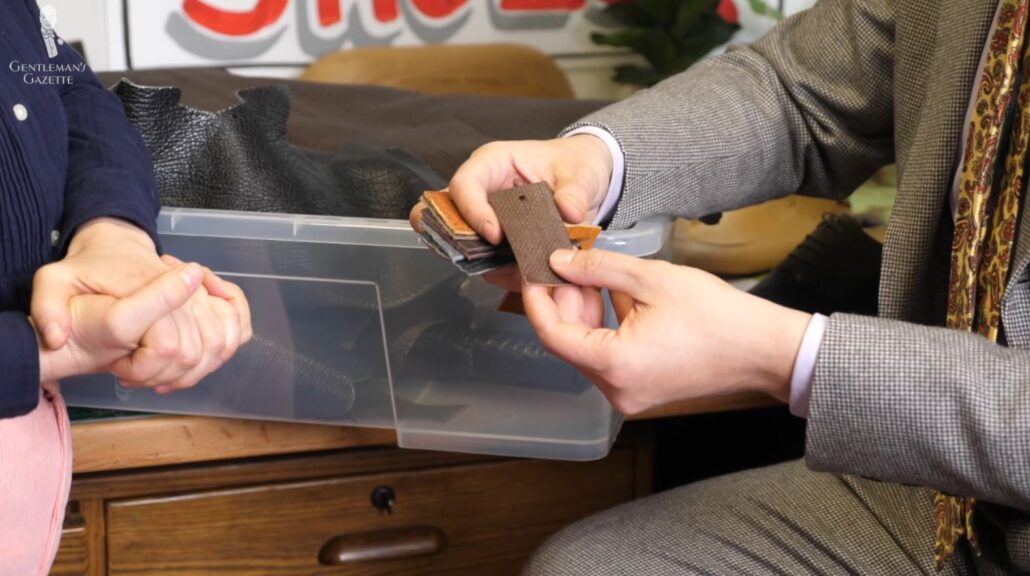
Keep in mind that your shoemaker will always be able to source more different and more exotic leathers but, of course, that will most likely increase the price. For example, choosing alligator leather over calf leather can get a bespoke shoe from $2,000-$3000 to over $10,000.
To learn more about why alligator and crocodile leathers are so expensive, check out the dedicated guide on that topic.
Why Are Crocodile & Alligator Leather Goods So Expensive?

Once you’ve talked about all the individual details, it’s time to look at them in conjunction and bring it all together. For example, now you can talk about the finishes, the broguing, whether you want a whole cut or not.
At this point, Amara already started drawing a side profile of the shoe and I just followed along. I used examples that I brought to help influence the final shape, and we settled on an Adelaide style, which is a special kind of Oxford. Of course, I didn’t just want the run-of-the-mill Adelaide style, but something more special. Now, rather than drawing on a piece of paper, Amara drew directly onto a last so we actually saw how it would look and feel on a real shoe, which I thought was pretty cool.

We went back and forth for a while because Amara really wanted to nail the shape also on the heel and everywhere else we worked on. In the end, our work paid off because Amara knew exactly what I was after.
If you take a closer look at the broguing, you will notice that most of them are round in different diameters. Well, I wanted something different and I had seen little squares that were rotated into a diamond shape or an actual diamond shape. Of course, she didn’t have the right tools for that, but she knew what I wanted so she could now go out, try to find the tools, then do some samples, and come up with something that would satisfy my taste. If that happens, of course, they’ll charge you more because they have to buy special tools just for you.
End Your Meeting Well
Eventually, once you’ve discussed all the details or you’re simply exhausted, your first bespeaking meeting will come to an end. At this point, your shoemaker will have a very good idea of what it is that you want, they will be able to start on the last, and order the leather.
Don’t be afraid. You can still make changes along the way. As long as the uppers are not actually made, you can still decide on something that you want to change. But, of course, you also want to be respectful and not just make changes over and over and over again.
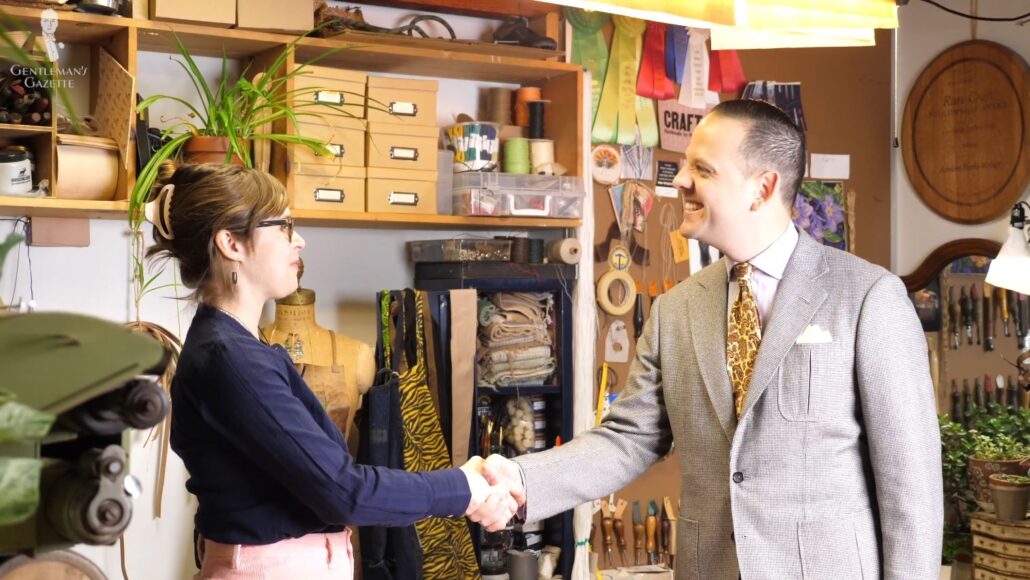
Because we were filming the entire process, we also made an appointment to meet about the last making. Normally, the shoemaker will make the last without you being present. Depending on the shoemaker, they will make a trial shoe and will ask you to come back for that – maybe they create a trial shoe that you can actually wear around your home – or some shoemakers operate without a trial shoe altogether.
As we depart, Amara made a great observation. She said, “nothing is final until the leather is cut.” If you think about it not, even that is true. Even if the leather is cut, you can still change your mind, but you’ll have to pay more because that leather is now wasted or will have to be used for a different pair of shoes.
How would you like to bespeak your dream shoe? Share about it in the comments!




I so appreciate this information on bespoke lasts and bespoke shoemakers.
I have been following Nicole Rudolph on YouTube. She shows how to make Women’s historical shoes.
My grandson lives in Australia. He has a wide foot and needs bespoke shoes. He is 14 and still growing.
Please suggest where he should look to begin having a last made.
We look forward to your informative and educational programs.
Kind regards,
Susan Habeler
Very happy to hear that you’re enjoying the bespoke shoe series, Susan!
Regarding your grandson’s shoe needs, it will depend on what style he is looking for, how the shoes will be used, and the budget that’s available. It will also depend on whether he’s looking to stay local to Australia or whether he will be able to travel to get a pair of bespoke shoes. When he knows what he’s looking for, he’ll be able to pinpoint a few makers that suit his style, use, and budget.
The runaway Sven went over the hill and he blew,
The runaway Sven went over the hill and he blew,
The runaway Sven went over the hill,
And the last we heard, he was going still
And he blew, blew, blew, blew, blew